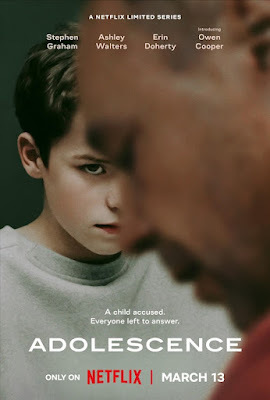Growing Pains: Exploring “Adolescence”
 Adolescence is a bland-sounding title for a limited TV series outof Britain that has accumulated eleven Emmy awardnominations. Winners in this prestigious category have included, over the decades, some of TV’sbest dramas, including Angels in America, The Queen’s Gambit, andseveral of Tom Hanks’ historical re-creations, including Band of Brothers andThe Pacific.
Adolescence is a bland-sounding title for a limited TV series outof Britain that has accumulated eleven Emmy awardnominations. Winners in this prestigious category have included, over the decades, some of TV’sbest dramas, including Angels in America, The Queen’s Gambit, andseveral of Tom Hanks’ historical re-creations, including Band of Brothers andThe Pacific. I have no crystal balltelling me who will take home the Emmy on September 14. I’m sure there are goodthings to be said about the other nominees: Black Mirror, Dying for Sex, Monsters: The Lyle and Erik Menendez Story, and The Penguin. But I’ll be rooting for Adolescenceto nab the top prizes in this category, both because of the importance ofits ideas and the excellence of its craft.
Adolescence has been widely described as a psychological crimedrama, and this is accurate, as far as it goes. At its center is a murder, andthe killer’s motives are certainly open to question. But there’s no emphasishere on tracking down the bad guy; this is not a case of rising suspense as thenoose tightens. First of all, we know almost from the very beginning that thekiller is an innocent-looking 13-year-old boy, who has dispatched a femaleclassmate with multiple stabs of a knife. The real question is: why did thishappen? Over the course of four one-hour episodes, the impact of the killing isapproached from four very different angles. What makes for exciting televisionis the fact that each of the four has a different focus, requiring us to see abloody but straightforward deed from very different perspectives.
And, thrillingly, each ofthese four episodes is shot in a single (though very complex) take, which hasthe effect of drawing us into what seems like a televised reality program. Thisis especially true of Episode 1, in which—without preliminaries—a heavily armedpolice squad bursts into a working-class English home, terrifying itsoccupants. They head directly for an upstairs bedroom where a boy cowers inbed, in a room brightly decorated with outer space images. Jamie is told to getdressed, then is hustled out of the room, leaving his well-worn teddy bearbehind. The murder charge seems as impossible to us as it does to his parentsand sister, and Jamie denies everything. Throughout we can’t help admiring theprofessional way the British cops make sure his rights are protected.
Episode 2 is led by a policedetective who visits the school attended by both killer and victim. Again theemotions are raw, as students mourn their dead classmate and try to avoid beingin any way implicated in the tragedy. But Detective Bascombe’s own son, anolder student at the school, clues his father in to Instagram practices thatmay hold a clue to what’s going on.
The heart of the drama isEpisode 3, entirely devoted to a session between Jamie and a forensicpsychologist. Here for the first time we grasp the complexity of the youngman’s emotions (Owen Cooper became theall-time youngest Emmy nominee in this category for this episode), and also thetoll they take on his professional but kindly questioner.
Perhaps the biggest surpriseis Episode 4, in which Jamie (facing trial) is only a voice on the telephone.That’s because we’re focused entirely on his well-meaning parents, who feeltremendous guilt for their son’s actions. The father, movingly played byStephen Graham (also the co-author of the series) is a kind, serious mandevoted to family life. Could he have stopped this tragedy? Could anyone?
Beverly in Movieland
- Beverly Gray's profile
- 10 followers



